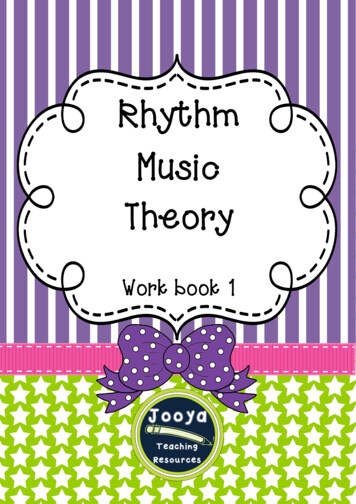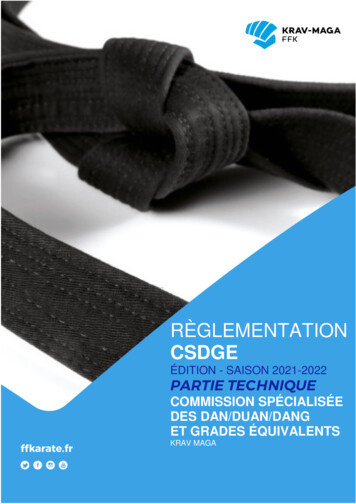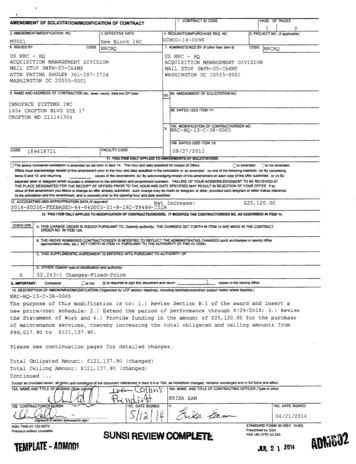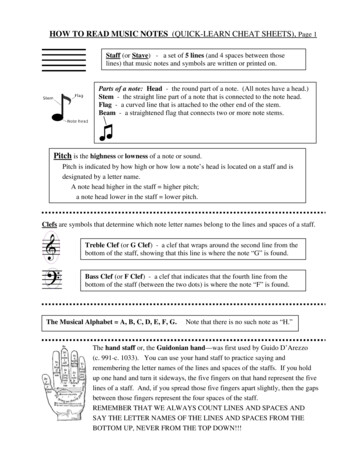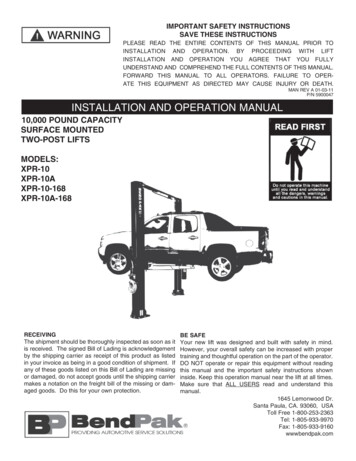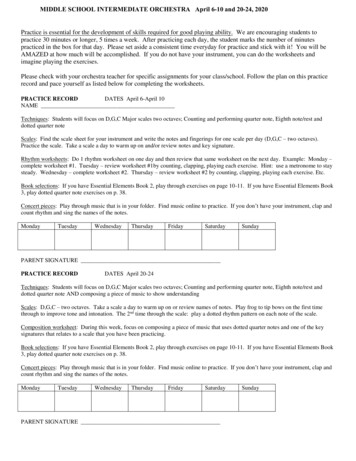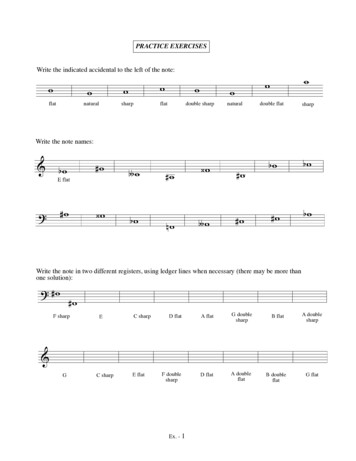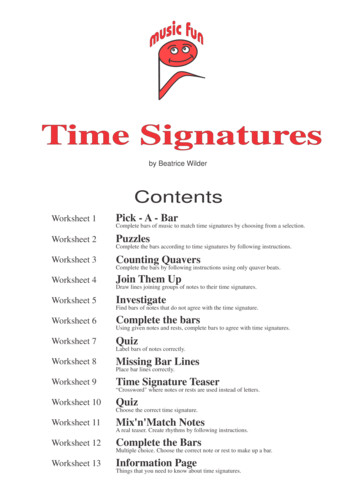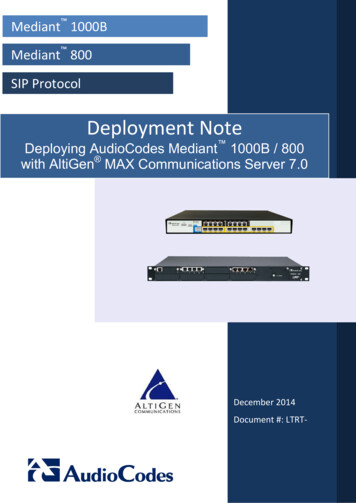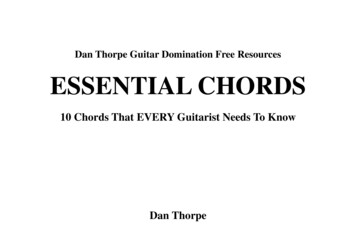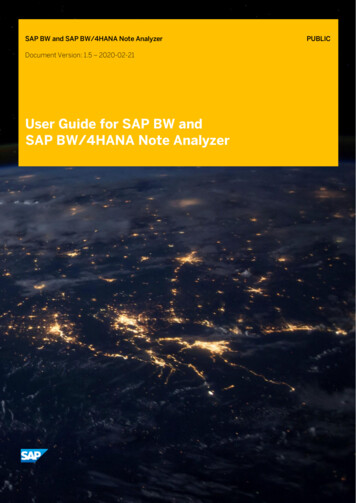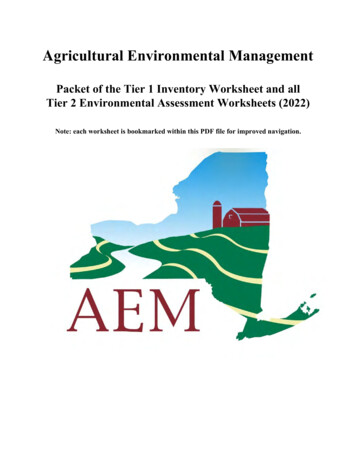
Transcription
Agricultural Environmental ManagementPacket of the Tier 1 Inventory Worksheet and allTier 2 Environmental Assessment Worksheets (2022)Note: each worksheet is bookmarked within this PDF file for improved navigation.
AGRICULTURAL ENVIRONMENTAL MANAGEMENTTier 1AEM Identification Number:County SWCDEvaluator Name:Date:Evaluating Agency:Watershed Identification:Farm Name:Owner’s Name:Operator’s il:Preferred Contact Point? (please check only one) Owner Operator1) Future Status of the FarmA) Do you anticipate any major modifications on your farm within the next 5 years? Yes NoIf yes, please check the condition(s) that best describes the modification(s): Business Structure Expansion Retirement Operation Type Diversification of Farm Business Sale of Farm Yes NoB) Do you plan to subdivide any portion of your farm in the next 5 years?2) Basic Farm InformationA) What Primary Farm Enterprise best describes your operation? Dairy Beef Horses Fruit/Vegetables Poultry Swine Vineyard Greenhouse Cash Crop: (Please Define) Sheep/Goats Other: (Please Define)B) Please indicate the following number of acres:Cropland AcresGrazed Land AcresPermanent Hay Land AcresWoodland AcresOwnedRentedWildlife Land AcresFarmstead AcresOther Acres:Total AcresC) Does your operation qualify for Ag Value Assessment? Yes No3) Animal Numbers for your Primary Farm TypeAverage Weight:Average Weight:Average Weight:July 2019Number:Number:Number:Average Weight:Average Weight:Average Weight:Number:Number:Number://
4) Management Questions (Please check Yes or No)Do you spread manure?Do you have a manure storage facility?Do you generate process washwater from the cleaning of product or facilities?(for example, milkcenter, egg wash, washing of produce)Is there a barnyard or outdoor feedlot on your farm?Do you store silage or other high moisture feeds on the farm?Do you utilize pastureland on your farm?Do you use commercial fertilizer?Do you use pesticides (herbicides, insecticides, fungicides) on your farm?Do you store and/or mix pesticides (herbicides, insecticides, fungicides) on your farm?Does your operation utilize cropland for row crop production?Is the water supply on your farm from a well or a spring?Is there a waterbody within or adjacent to your farm?Do you presently or do you plan to harvest timber on your farm?Do you store fuel or other bulk petroleum products on your farm?Have you received odor complaints or do you believe your farm has an odor concern?Yes No Other Agricultural Conservation Interests – check all that are of interest Adapting to Extreme Weather (storms, drought, heat)Agricultural Tax ReliefAgri-TourismAir QualityBiofuelsBiosecurityConservation EasementsEnergy Conservation/GenerationFarmland ProtectionFeed ManagementFisheries Habitat ManagementForest Management/Timber HarvestGrasslands FarmingGreenhouse Gases Integrated Pest ManagementIrrigation ManagementManure Treatment OptionsNeighbor-Farm RelationsNuisance Wildlife ControlNYS Grown and Certified ProgramOrganic FarmingPollution Credit TradingRight-to-FarmStream Management/BuffersWater Conservation/ManagementWellhead ProtectionWetland ConservationWildlife Habitat ImprovementWould you like to receive a copy of the AEM Guide to Conservation Funding?This document is also online at www.nys-soilandwater.org/aem/aemoutreach.html Yes No(OPTIONAL)Producer Questions & Comments (for example, if the farm has done work with the District or NRCS on conservation practices; ifany land is in a conservation easement; if the farm has any certifications, such as organic; or any additional questions or info onanswers in the Tier 1, above):July 2019
AgriculturalEnvironmentalManagement“MAKING THE CONNECTION”(Linking Tier 1 to Tier 2)TIER I QUESTIONNAIRERESPONSETIER II WORKSHEETFarm TypeAllWatershed Site EvaluationFarm TypeAllAgriculture and the CommunityFarm TypeAllGreenhouse Gas Mitigation OpportunitiesFarm TypeAllWaste DisposalFarm TypeAny LivestockWater-borne PathogensFarm TypeDairyManagement of Feed NutrientsFarm TypeHorse VineyardGreenhouseFruit/VegetableUtilize specialized Worksheets, as well asthose indicated as needed below.Do you spread manure?YesManure ManagementDo you have a manure storage facilityYesManure ManagementIs there a barnyard or feedlot on your farm?YesBarnyardsDo you store silage on the farm?YesSilage StorageDo you generate process wash water from thecleaning of product or facilities?(i.e. milkcenter, egg wash, washing of produce)YesProcess Wash WaterDo you utilize pastureland on your farm?YesPasture ManagementDo you use fertilizer?YesFertilizer ManagementDo you use pesticides (herbicides, insecticides,fungicides) on your farm?YesPesticide UseDo you store and/or mix pesticides (herbicides,insecticides, fungicides) on your farm?YesPesticide Storage, Mixing and LoadingDoes your operation utilize cropland?YesSoil ManagementIs the water supply on your farm from a well or aspring?YesFarmstead Water Supply EvaluationIs there a defined stream within or adjacent to yourfarm?YesStream & Floodplain ManagementDo you presently or do you plan to harvest timberonyour farm?YesForest ManagementDo you store petroleum products on your farm?YesPetroleum Product StorageHave you received odor complaints or do youbelieve you have an odor concern?YesLivestock Odor Management
AEM TIER 2 WORKSHEETS – 3/2018Access Worksheets at www.nys-soilandwater.orgCore Worksheets1. Watershed Site Evaluation2. Agriculture and the Community3. Greenhouse Gas MitigationOpportunities4. Soil Management5. Nutrient Mgmt: Manure & Fertilizer6. Manure & Fertilizer Storage7. Waste Disposal8. Pesticide Use9. Pesticide Storage, Mixing, &Loading10. Farmstead Water Supply Evaluation11. Stream and Flood Plain Management12. Petroleum & Oil Products Storage13. Forest Management14. Irrigation Water ManagementDairy/Livestock1. Heavy Use Area Protection2. Silage Storage3. Process Wash Water4. Management of Feed Nutrients5. Water-Borne Pathogens6. Pasture Management7. Livestock Odor ManagementVineyards (VineBALANCE)1. Vineyard Management2. Irrigation Management3. Nutrient Management4. Soil Management5. Weed Management6. Pest Management7. Pesticide Management8. Continuing EducationVegetables & Fruit1. Tree Fruit2. Vegetables & Small FruitHorse1. Wash Rack/Stall & Trailer WashArea2. Manure Management for Horses:Nutrient Management, Storage, FieldApplication &/or Off-farm Disposal3. Horse Farm – Outdoor Paddock &Arena Management4. Horse Farm - Waterborne PathogenManagementGreenhouse1. Greenhouse Maintenance2. Pest Management3. Fertilizer StorageLong Island1. Nutrient Managementa. Greenhouse IrrigationSystemsb. Grapesc. Vegetablesd. Tree Fruite. Sod/Turff. Field Grown Nursery Crops2. Pest Managementa. Grapes3. Irrigation, Well, & WaterManagement4. Soil Management5. Petroleum Products Storage6. Waste Management
CountyAgricultural Environmental Management (AEM)Program TeamAEM Tier 2 Summary ReportAEM ProjectFarm NameContact NameAddressPhoneEvaluatorPhone:Date PreparedWorksheet Nameand Number1. Watershed SiteEvaluationDate DeliveredLevel ofConcern(1-4)Items ofConcernEvaluation & RecommendationsDetails Captured on Tier 2Worksheet2.3.4.5.Page 1C:\Documents and Settings\bsilvest\Local Settings\Temporary Internet Files\OLKD4\AEM Tier 2 Summary Report Fillable Form (2).doc
Worksheet Nameand NumberLevel ofConcern(1-4)Items ofConcernEvaluation & RecommendationsPage 2C:\Documents and Settings\bsilvest\Local Settings\Temporary Internet Files\OLKD4\AEM Tier 2 Summary Report Fillable Form (2).doc
AEM Tier 2 WorksheetWatershed Site EvaluationBackgroundWhat happens on the land effects the water. The type of farm activities occurring, along with a farm’s soil, topography, and location within awatershed, affect the farm’s risk for pollution of ground and surface water. This worksheet helps farmers know their watershed, and the associatedwater quality issues and opportunities within the watershed their farm may be impacting at the local, state, and national levels.Every surface waterbody in New York State has been classified by the Department of Environmental Conservation (DEC) according to its "best use.”Best use categories include: drinking water supply, public bathing, recreation, aquatic life support, fish consumption, shell fishing, natural resourceshabitat/hydrologic use, and aesthetics. Each use has a set of standards associated with it that limit the concentrations of various contaminates that canbe present in the water.A water quality problem exists where a classified best use is negatively impacted. The effects can range from precluding a use to situations where awaterbody’s best use is threatened as defined below:Precluded: Frequent/persistent water quality or quantity conditions and/or associated habitat degradation prevents all aspects of the waterbodyuseImpaired: Water quality and/or habitat characteristics frequently impair a classified use. Also applied when the classified use is supported, butat a level significantly less than what would be expected. Natural ecosystem functions may be disrupted. These waters have severe impacts.Stressed: Waterbody uses aren’t significantly limited or restricted, but occasional water quality, or quantity conditions and/or associated habitatdegradation periodically discourage the use of the waterbody.Threatened: Water quality presently supporting best use and ecosystem experiencing no obvious signs of stress; however, existing or changingland use patterns may result in restricted use or ecosystem disruption. These waters are the least impacted.The primary pollutants impacting best uses can result from land use activities within a watershed and include nutrients (phosphorus and nitrogen),sediment, toxic substances (pesticides and petroleum products), pathogens, oxygen-demanding substances (organics such as manure and whey) andelevated water temperatures (thermal stress). In any given watershed there are a number of potential sources of these pollutants such as: agriculture,timber harvesting, construction activities, land disposal of waste, and modifications to streambanks or stream channels.In many areas of the state there are watershed management plans or aquifer/wellhead protection plans that identify pollutants of concern and land usesor activities that pose a potential risk to water quality. Agricultural Environmental Management (AEM) Strategic Plans at the County level addressagricultural sources of pollution that may impact water quality.1
GlossaryAEM ID: Date:Aquifer: Water bearing soil or rock formation that is capable of yieldingusable amounts of water.Leaching Potential: Estimate of the possibility for the downwardmovement, through the soil, of chemical substances dissolved in water.Best Management Practice (BMP): Methods, measures or practicesdetermined to be the most practical and effective in preventing or reducingthe impact of pollutants generated by nonpoint sources.Pathogens: Any microorganism that causes disease, such as a bacterium orvirus.Concentrated Flow: The rapid flow of water through a field that may resultin the formation of gullies.Primary Aquifer: Highly productive aquifers (yields greater than 50gallons per minute, thickness of saturated deposit greater than 20 feet, or areaof aquifer 5 to 10 square miles).Contamination: Alteration of a water resource by the introduction of achemical or other substance or the raising of water temperature so that thewater resource is unfit for a specified use.Principal Aquifers: Potential sources of public drinking water with yieldsgreater than 10 gallons per minute that are not presently being usedintensively as a water source by a major municipal system.Erosion: Detachment and movement of soil caused by rain or surface waterrunoff.Runoff: That portion of precipitation; such as rain, snowmelt or irrigationwater; that flows over the land surface.Hardpan: Also referred to as fragipan, is a dense and brittle layer in soilsthat owe their hardness mainly to extreme density or compactness rather thanhigh clay content or cementation. This layer is so dense that roots cannotpenetrate and water moves through it very slowly.Sinkhole: A natural depression in a land surface that connects with asubterranean passage. Sinkholes usually occur in limestone regions and areformed by solution or collapse of a cavern roof.Highly Erodible Land (HEL): Land containing soils with a highsusceptibility to erosion when cultivated based on soil erodibily, slope, slopelength and rainfall factors.Hydrologic Soil Group: Refers to soils grouped according to their runoffand leaching characteristics.Hydrologic Unit Code (HUC): A numerical designation for catalogingwatersheds nationwide used by the U.S. Geological Service and the USDANatural Resources Conservation Service.Land Capability Class: Shows in a general way suitability of soils forgrowing crops. Capability classes are designated by Roman numerals I –VIII. The numerals indicate progressively greater limitations. The subclass“w” indicates that water in or near the soil interferes with plant growth orcultivation.AEM Tier 2 Worksheet –Watershed Site Evaluation - Revised 10/12Soil Map: A map showing where various soil types are distributed in agiven area (most often published in a county report).TMDL: A Total Daily Maximum Load (TMDL) is a regulatory term in theClean Water Act describing the value of the maximum amount of a pollutantthat a waterbody can receive while still meeting water quality standards.Alternatively, TMDL is an allocation of that water pollutant deemedacceptable to the subject receiving waters.Waterbody: A lake, pond, stream, river, reservoir, wetland or bay.Watercourse: Water flowing over a non-vegetated channel to a waterbody.Watershed: The geographic region within which water drains to a particularriver, stream, or body of water. Large watersheds may be composed ofseveral sub-watersheds.Page 2 of 8
Tools and ReferencesAEM ID: Date:The following tools and references may be helpful when filling out this worksheet:Your county’s AEM Strategic PlanUSDA Natural Resource Conservation Service (NRCS) County Soil Survey Report, Soil and Water Features age.htmNRCS Field Office Technical Guide, Sections I and II; http://efotg.sc.egov.usda.gov/efotg locator.aspx7.5 minute U.S. Geological Survey (USGS) Topographic Map;GIS based aquifer maps for NYS: tmRegional scale surficial & bedrock geology maps for NYS: http://www.nysm.nysed.gov/gis/AEM Tier 2 Worksheet –Watershed Site Evaluation - Revised 10/12Page 3 of 8
AEM ID: Date:Part 1: Potential Water Resource Concerns for the FarmPart 1: ContinuedA. Potential Farm Groundwater IssuesHas there been groundwater contamination or concerns about groundwater issues on or near the farm? Yes No6.yes,Do youfarm slopes in excess of 8 percent slope? Yes NoIfexplainIs thefarm,theincludingcrop soilfields,adjacentto homesthat ,relyonwithwellsor springfor soilsdrinkingYesNo(i.e.7. Arepredominatetypesyou farmclay soilssoilsa highwaterdevelopmentstable or shallowoverwater?an imperviouslayerfragipan orbedrock)? Yes NoIs the farmstead or any of the crop fields within 300 feet upslope or at grade with the wellheads or springs? Yes No8. Do you have problems with soil erosion on your farm? Yes NoIf yes, describe locations:9. Are BMPs installed for controlling surface water runoff on your farm? Yes No10. Has it been longer than five years since you’ve reviewed your farm’s conservation plan, or do you not have one? Yes NoDoes the farm sit atop a primary or principal aquifer? Yes No Identify:2: FarmPotentialResourceB.PartPotentialSurface WaterWater IssuesConcernsIn which watersheds and sub watersheds is the farm located? Note: the farm may be in more than one watershed, if so list all watersheds.Potential Groundwater Issues for Your FarmNameTwelveHUC Watershed(s)Has oftherebeen Digitany groundwatercontaminationor concern about groundwater issuesnear your farm?YesExplainNoNameof stream(s)Nameof river(s)Do yourneighborshave wells or spring developments adjacent to your farm?NoYesDescribeNameof lake/reservoir,bay or estuaryDoIsanyof athewatersheds/subwatershedsabovehavea TMDL designation? Yes Nothereprimaryor principalaquifer tantsof protectionconcern nt areas for public water supply wells that extend on to your farm?NoYesDescribeAEM Tier 2 Worksheet –Watershed Site Evaluation - Revised 10/12Page 4 of 8
AEM ID: Date:C. NYSDEC Waterbody Inventory & Priority Waterbodies ListIn order to fulfill certain requirements of the Federal Clean Water Act the New York State Department of Environmental Conservation must provideregular, periodic assessments of the quality of the water resources of the state. This information has been compiled into an inventory data base usedto record current water quality information, characterize known or suspected water quality problems and issues, and track progress toward theirresolution. www.dec.ny.gov/chemical/36730.htmlAre any of the waterbody(s) listed in Section B of this worksheet included on NYSDEC’s Waterbody Inventory/Priority Waterbody List (WI/PWL)?Yes No .If yes, summarize information available from the Waterbody Inventory Data Sheet in the table below:Waterbody NameClassified UseUse ImpairmentAEM Tier 2 Worksheet –Watershed Site Evaluation - Revised 10/12Severity (level ofimpact ts ofConcernKnown orSuspected Sources(circle if primary)Page 5 of 8
AEM ID: Date:D. Identification of Public Drinking Water Sources – NYSDOH Source Water Assessment ReportThe New York State Department of Health (NYSDOH) has conducted a susceptibility analysis of each source of water that is used to supply drinkingwater to the public. N ote: assessment reports were provided to Conservation Districts by the N Y SDOH in February 2005 containing assessmentsfor all the public water systems in the county. Since the information used to create these reports is now over 10 years old, Districts may add or deleteinformation related to the “Contaminants of Concern” to reflex current conditions as appropriate.Use the table below to summarize the potential sources of contamination for those public water supply sources such as rivers, lakes orreservoirs downstream from the farm or public wells within one mile of the farm that are at risk from agricultural activities.Source Water Assessment Summary of Significant FindingsName of public drinking water supplyWater Source (e.g. spring, well, river, lake, reservoir)Potential Sources of ContaminationPotential Impacts to WaterSourceAEM Tier 2 Worksheet –Watershed Site Evaluation - Revised 10/12Contaminates of ConcernDescriptionPage 6 of 8
AEM ID: Date:Part 2: Farm Soils/TopographySoils on a farm vary in their ability to transmit water to surface and groundwater sources. The potential for runoff and leaching can be assessed fordifferent soil types by referring to the County Soil Survey/Web Soil Survey mIf potential ground water concerns were identified in Part 1 of this worksheet there may be a heightened risk of groundwater pollution ifsoils are farmed that (check below):Are glacial outwash or well drained alluvial soils over sand or gravel deposits.Are less than 20” to fractured bedrock.Contain sinkholes, or are less than 40” deep over limestone.Adjacent to/or above the farm’s water supply (well or spring).Or, if surface water concerns were identified in Part 1 there may be a heightened risk of polluting nearby waterbodies if soils are farmedthat (check below):Have slopes greater than 8 percent, or are highly erodible (HEL) that lack best management practices for controlling surface runoff.Are predominately clay soils, or shallow soils over hardpan or unfractured bedrock.Have seasonal concentrated flows or conservation practices such as subsurface drainage tile that directly outlet into a waterbody.Are seasonally saturated (land capability class 2w or wetter).Are within 100 feet of a waterbody.Flood frequently (once every 2 years).Those areas checked above are considered hydrologically active areas. These are areas that can have a high potential for transporting pollutantsto surface and groundwater depending on their location (proximity to a waterbody) and type of farming conducted on them.AEM Tier 2 Worksheet –Watershed Site Evaluation - Revised 10/12Page 7 of 8
AEM ID: Date:List areas of the farm to be assessed further based on the results of Part 2 of this worksheet, as these areas of the farm may be hydrologically activeand should be a priority for Tier 3 planning:Part 3: Other Natural Resource Concerns/OpportunitiesAre there programmatic or additional natural resource concerns or opportunities identified for the watershed or the farm: (please check or identify)Threatened or endangered speciesInvasive speciesAir quality non-attainment areaFarmland protection participantConcentrated Animal Feeding OperationState or Federally regulated wetlandCertified Organic farmOther:AEM Tier 2 Worksheet –Watershed Site Evaluation - Revised 10/12Page 8 of 8
AEM Tier 2 WorksheetAgriculture & the CommunityPurpose of this Worksheet1. Value to the Local Tax Base1. Document the economic, social,recreational and environmental benefitsof a farm to the community in which it islocated.For every dollar paid in taxes, residential areas require 1.11 in publicservices compared to only .33 cents in services required by farmers*.This information can be used to calculate how farms keep the tax base low ina community by requiring much less in public services than residential land.For example:2. Identify opportunities for a farm toimprove neighbor and communityrelations.Farmland:A 100 acre farm pays 12,000 per year in taxes: 12,000 (taxes) x .33 (cost of services) 3,960 in public services annually.This worksheet should be completed when neighborrelations have been identified as a concern in the TierI questionnaire, or if a farm will be part of a watershedprotection effort.This worksheet should also be completed if amunicipality (town or county) is undertakingfarmland preservation efforts and wants to documentthe multiple public benefits of retaining a viableagricultural industry within the community.This farmland provides a savings to the town of 8,040 per year.Residential Property:The same 100 acre farm is developed where zoning allows for 1/2 acre lotsand average taxes are 2000 per year:200 (1/2 acre lots) x 2000 (tax) x 1.11 (cost of services) 444,000in public services annually ( 2,220 per lot) 2,220 (cost per lot) – 2000 (tax) 220 per residence x 200 44,000per year more in the cost of services than generated by taxes.The development of this farm into residential lots costs the town 44,000 peryear more to provide public services than what is generated by taxes.* Source: American Farmland TrustAEM Tier 2 Worksheet – Agriculture and the Community - 6/05Page 1 of 8
2. Farm’s Contribution to Local Food Supply Farm products locally grown and sold (list products) Marketing Mechanism (check those that apply):Cooperative: Producer/GrowerDirect:RestaurantFoodStoreRoadside StandFarmers’ MarketSupermarket ChainOther (list)3. Contribution to Local EconomyEconomic activity generated by the agricultural sector tends to have a larger impact on the local economy than dollars produced by otherindustries. Farmers typically spend more locally than other businesses, since they rely on a variety of local businesses such as feed andseed dealers, fertilizer and fuel companies, machinery dealerships and repair shops, veterinarians, grain haulers, etc. Local Businesses Utilized: Families Supported : Farm’s Gross Sales (circle one) 10,000 10,000 - 99,000 100,000 - 500,000 500,000The economic multipliers listed below can be used with gross sales data to determine the local contribution of an individual farmand compiled to reflect the economic contribution of farms in your county or watershed:Gross Salesx (Income Economic Multiplier *) Jobs Provided x (Employment Economic Multiplier **) * Total Income Economic Multipliers: Dairy 2.29, Crops 2.28, Nursery 1.78, Poultry and Livestock 1.64** Employment Economic Multipliers: Dairy 1.52, Crops 1.51, Nursery 1.39, Poultry and Livestock 1.37(Source: NYS Dept. of Labor and CALS/Cornell University)AEM Tier 2 Worksheet – Agriculture and the Community - 6/05Page 2 of 8
4. Public Recreational Benefit Public Access Allowed Recreational Opportunities Available (check those that apply): YesNoHikingHuntingCross country skiingSwimmingSnowmobilingPicnickingFishingOther (list)Comments:5. Tourism Benefits Farm is part of a desired view shedYesNo that promotes tourismYesNo that adds to the quality of life in the communityYesNo6. Farm LocationAdditional opportunities and considerations can be determined based on farm location. Proximity of farm relative to:Nearby or DistantCommentsRecreational or wilderness areasAgricultural businessesNonagricultural businessesResidential housingPublic buildingsTourist areasAEM Tier 2 Worksheet – Agriculture and the Community - 6/05Page 3 of 8
7. Farmland Preservation Does this farm contain a conservation easement?YesNo Is this farm part of an Agricultural District?YesNo Does this farm have a conservation (CNMP) plan that is being followed?Yes No Acres of prime and important farmland soils: Recent capital improvements to farm (list): Historical significance of farm (explain):8. Drinking Water Supply Protection Benefits Is the farm located within the:recharge area of public well?YesNowatershed of reservoir, river etc. that provides public drinking water?YesNoIf yes, are conservation (best management) practices being installed to protect a down gradient drinking water supply? Yes NoIdentify practices:9. Archeological Sites & Other Protected Cultural Resources Have archeological sites and other cultural resources been identified? YesNo Are these sites and resources adequately preserved?NoYes10. Rural Fire Protection Benefits Does the farm contain a pond or other water source that local fire departments have year-round access to when fighting fires in the area?Yes NoAEM Tier 2 Worksheet – Agriculture and the Community - 6/05Page 4 of 8
11. Natural Resource Protection & Enhancement Benefits Stream Corridor Management:length of streambankfeetlength of riparian buffers being maintainedfeetlength of riparian buffers being installedfeetacres of floodplain not being encroached uponacresstream bank and shoreline protection measures installedfeet; typefish stream improvement measures installedfeet; typespawning areas maintained for (type of fish) Woodland Management:AcresForest typeDo you have a forest management plan? YesNoIf yes, have you implemented erosion and sediment control practices when conducting timber harvesting activities? Yes NoHave you planted trees? YesNoIf yes, purpose: reforestation acreswindbreak feetother (list) Wildlife Management:Types of game species presentWildlife upland habitat management acresSpecies being managed forThreatened and/or endangered species habitat: YesAEM Tier 2 Worksheet – Agriculture and the Community - 6/05NoPage 5 of 8
Wetlands Protection/Restoration:Total acresTypesAcres protectedAcres restoredAcres constructedAcres enhancedObjectives of wetlands improvement:Flood protectionWater quality protectionAquatic wildlife habitat management Erosion and Sediment Control:Does the farm contain Highly Erodible Land (HEL) acres?YesNoYesNoIf yes: HEL acreageAre these HEL acres adequately protected from erosion?12. Environmental Protection Are you implementing practices to control:erosion?YesNonutrient runoff/leaching?YesNopesticide re on roads?YesNonoise?YesNoflies?YesNo Comments:AEM Tier 2 Worksheet – Agriculture and the Community - 6/05Page 6 of 8
13. Environmental Impact Monitoring Do you consider how your farm activities affect:Water quality YesNoAir qualityYesNoSoil qualityYesNo Do you regularly inspect and maintain your conservation practices to ensure they are operating effectively? YesNo Comments:14. Neighbor Relations Do you:pay attention to the appearance of your farm and farm equipment?Yes Nohave an information sheet about the farm operation listing contact information for questions and concerns?YesNoconsider neighbor concerns regarding issues such as pesticide application, manure storage and spreading?YesNohold an open house on the farm?YesNohost a community picnic?Yes Noprovide sample farm products?YesNoprovide labor or equipment assistance for emergencies?YesNoprovide information/remediation for any spills?YesNoallow use of your farm for educational and/or research purposes? If yes, list groups below:YesNoother:AEM Tier 2 Worksheet – Agriculture and the Community - 6/05Page 7 of 8
15. Practices in Consideration of Neighbor Concerns Management practices implemented or modified in consideration of neighbor concerns:manure incorporationYesNotiming of manure spreadingYesNotiming of pesticide applicationYesNotiming of roadway useYesNotiming of field workYesNoother: Comments:AEM Tier 2 Worksheet – Agriculture and the Community - 6/05Page 8 of 8
AEM Tier 2 WorksheetGreenhouse Gas Mitigation OpportunitiesGlossaryAdaptation: Management changes to reduce risk and/orrealize opportunities presented by climate change
Business Structure Expansion Retirement Operation Type Diversification of Farm Business Sale of Farm B) Do you plan to subdivide any portion of your farm in the next 5 years? Yes No 2) Basic Farm Information A) What Primary Farm Enterprise best describes your operation? Dairy Beef Horses Fruit/Vegetables
